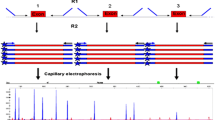Abstract
Multiplex ligation-dependent probe amplification (MLPA) is based on simultaneous multiplex PCR of specific probes that hybridize to multiple different target DNA regions. The method can identify copy number changes, gross gene rearrangements, methylation patterns or even point mutations. MLPA has been a reliable approach to identify copy number changes in the clinical and research settings and is widely used for the screening and investigation of copy number variations and genomic aberrations of interest in various diseases. In this chapter the analysis of the copy number changes in the RB1 gene locus by MLPA is described.
Access this chapter
Tax calculation will be finalised at checkout
Purchases are for personal use only
Similar content being viewed by others
References
Kivelä T (2009) 200 years of success initiated by James Wardrop’s 1809 monograph on retinoblastoma. Acta Ophthalmol 87:810–812
Lohmann DR, Gallie BL (2004) Retinoblastoma: revisiting the model prototype of inherited cancer. Am J Med Genet 129C:23–28
Leiden Open Variation Database. http://rb1-lovd.d-lohmann.de/home.php?select_db=RB1. Accessed 15 Feb 2017
Harbour JW (1998) Overview of RB gene mutations in patients with retinoblastoma. Implications for clinical genetic screening. Ophthalmology 105:1442–1447
MacCarthy A, Bayne AM, Brownbill PA et al (2013) Second and subsequent tumours among 1927 retinoblastoma patients diagnosed in Britain 1951–2004. Br J Cancer 108:2455–2463
Kleinerman RA, Yu CL, Little MP et al (2012) Variation of second cancer risk by family history of retinoblastoma among long-term survivors. J Clin Oncol 30:950–957
Hömig-Hölzel C, Savola S (2012) Multiplex ligation-dependent probe amplification (MLPA) in tumor diagnostics and prognostics. Diagn Mol Pathol 21:189–206
Aoyama Y, Yamamoto T, Sakaguchi N et al (2015) Application of multiplex ligation-dependent probe amplification, and identification of a heterozygous Alu-associated deletion and a uniparental disomy of chromosome 1 in two patients with 3-hydroxy-3-methylglutaryl-CoA lyase deficiency. Int J Mol Med 35:1554–1560
Zauber P, Marotta S, Sabbath-Solitare M (2016) Copy number of the Adenomatous Polyposis Coli gene is not always neutral in sporadic colorectal cancers with loss of heterozygosity for the gene. BMC Cancer 16:213
Wang J, Ai X, Qin T et al (2017) Multiplex ligation-dependent probe amplification assay identifies additional copy number changes compared with R-band karyotype and provide more accuracy prognostic information in myelodysplastic syndromes. Oncotarget 8:1603–1612
Yalniz Z, Demokan S, Karabulut B et al (2017) Copy number profiling of tumor suppressor genes in head and neck cancer. Head Neck 39:341–346
Price EA, Price K, Kolkiewicz K et al (2014) Spectrum of RB1 mutations identified in 403 retinoblastoma patients. J Med Genet 51:208–214
Dommering CJ, Mol BM, Moll AC et al (2014) RB1 mutation spectrum in a comprehensive nationwide cohort of retinoblastoma patients. J Med Genet 51:366–374
He MY, An Y, Gao YJ et al (2016) Screening of RB1 gene mutations in Chinese patients with retinoblastoma and preliminary exploration of genotype-phenotype correlations. Mol Vis 20:545–552
Shahraki K, Ahani A, Sharma P et al (2016) Genetic screening in Iranian patients with retinoblastoma. Eye (Lond) 31:620–627
Ahani A, Akbari MT, Saliminejad K et al (2013) Screening for large rearrangements of the RB1 gene in Iranian patients with retinoblastoma using multiplex ligation-dependent probe amplification. Mol Vis 19:454–462
Khalid MKNM, Yakob Y, Yasin RM et al (2015) Spectrum of germ-line RB1 gene mutations in Malaysian patients with retinoblastoma. Mol Vis 21:1185–1190
Schouten JP, McElgunn CJ, Waaijer R et al (2002) Relative quantification of 40 nucleic acid sequences by multiplex ligation-dependent probe amplification. Nucleic Acids Res 30:e57
Nygren AO, Ameziane N, Duarte HM et al (2005) Methylation-specific MLPA (MS-MLPA): simultaneous detection of CpG methylation and copy number changes of up to 40 sequences. Nucleic Acids Res 33:e128
Bunyan DJ, Eccles DM, Sillibourne J et al (2004) Dosage analysis of cancer predisposition genes by multiplex ligation-dependent probe amplification. Br J Cancer 91:1155–1159
Atanesyan L, Steenkamer MJ, Horstman A et al (2017) Optimal fixation conditions and DNA extraction methods for MLPA analysis on FFPE tissue-derived DNA. Am J Clin Pathol 41:1443–1455
Author information
Authors and Affiliations
Corresponding author
Editor information
Editors and Affiliations
Rights and permissions
Copyright information
© 2018 Springer Science+Business Media, LLC
About this protocol
Cite this protocol
Dalay, N. (2018). Detection of RB1 Gene Copy Number Variations Using a Multiplex Ligation-Dependent Probe Amplification Method. In: Santiago-Cardona, P. (eds) The Retinoblastoma Protein. Methods in Molecular Biology, vol 1726. Humana Press, New York, NY. https://doi.org/10.1007/978-1-4939-7565-5_2
Download citation
DOI: https://doi.org/10.1007/978-1-4939-7565-5_2
Published:
Publisher Name: Humana Press, New York, NY
Print ISBN: 978-1-4939-7564-8
Online ISBN: 978-1-4939-7565-5
eBook Packages: Springer Protocols




